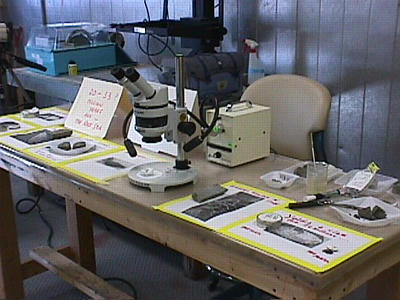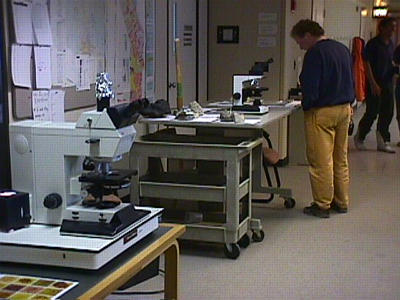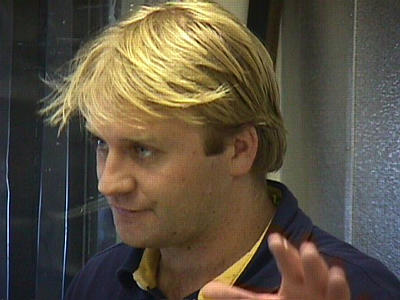6 December, 1998
Sunday, December 6th, 1998
Hi! Today was the open house for the Cape Roberts Project. I was busy this
morning getting ready. I had taken black and white photos of scientists at
work and I hung those on the wall in our main corridor. Since these were 5 x
7 enlargements, people could get a good look at our teams in action. I also
had to move a computer on a cart to the hallway near the photographs. This
was my "station" during the open house. I was there to provide information on
the "Teachers Experiencing Antarctica" program and my role here with the Cape
Roberts Project.
The open house was scheduled to take place from 1:00 PM until 4:00 PM, but we
never got finished until more like 4:45 PM. There was a constant stream of
visitors for the entire time. People were organized into small groups of
about a dozen or so, and they were taken through the various stations by a
"minder" (which I have determined is the New Zealand expression for a tour
guide). All together, there were 7 major stations, but some of those had many
components to them.
Visitors began their tour at the entrance to Crary Lab, with Todd Symon, one
of the drillers from out at the camp/drill site. He explained the drilling
process and showed some of the pieces of equipment used in drilling for core
under the sea floor. He talked about the movement of the sea ice, the diamond
drill bits, the process of linking the pieces of the drill pipe together,
drilling "mud" and fluid, the floats under the sea riser, and many other
topics. It was important to have someone present information about the drill
site, to give visitors the background information to understand the process of
obtaining the core that we worked on here in Crary Lab. There was also a tv
hooked up to a video that showed the bottom of the sea floor-taken with the
camera I talked about after my visit to Cape Roberts. The cameras were used
to monitor the place on the sea floor where the drill entered the floor of the
ocean. They were also used to monitor the floats used to buoy up the sea
riser.
The next stop was Tim Naish, who gave out seismic survey information. This
information is used to locate where to put the drill hole. It was used for
CRP1 (last year's hole) and CRP2 (this year). However, when they drilled the
hole this year, they went much farther down than last year. When they drilled
this year's hole, the results were completely different than what the seismic
survey had indicated. Scientists took a look at the stratigraphy of the drill
hole and they will use this information to calibrate the seismic data, so that
next year they can do a better job when they start to drill CRP3.
Jason Brink and the other downhole loggers represented station #3. This part
of CRP is involved with the geophysics and uses sophisticated equipment to
measure the physical properties of the rocks in the drill hole. The downhole
loggers lower their instruments into the drillhole and measure the magnetic
susceptibility, density, and velocity of the rocks inside the side walls of
the bore hole. Instead of pulling the rocks out to examine them (as we do
with the core), they measure the rocks still in place in the bore hole. The
loggers take their data and compare it with the stratigraphy of the core.
They look for changes in the physical characteristics of the rock which might
relate to how the rocks were deposited. These scientists look for cycles or
patterns in the sediments.
Station #4 was my display and demonstration of the "Glacier" web site. I
showed people how to access the web site, told them about the Teachers
Experiencing Antarctica program, showed them examples of my journals and
digital photographs, and answered their questions. I was surprised at the
response and there were many positive comments about the TEA program, and
parcticipation of teachers in the science projects taking place in Antarctica.
Some of the groups were able to visit the paleomag lab and learn a little bit
about the magnetostratigraphy of the core and the samples we took. Gary and
Leo demonstrated the spinner magnetometer, showed visitors some of our
cylindrical samples, and explained how this information fits into the Cape
Roberts Project. The paleomag team had also displayed some of our data on the
wall, and this was interpreted for visitors.
The micropaleontology teams set up a huge display, arranged in the open
meeting space down the hall. Microscopes were set up on tables, and examples
of microfossils were explained to visitors as they checked out the various
microscopes. Franco was also available with a display on petrology-the
mineral content of the rocks.
Finally, in the core sampling lab, 6 boxes of core were on display. Jaap
talked about the procedure of sampling the core and explained the role of the
curators. Marco had a display on macropaleontology (macro fossils---those we
can see). John discussed the volcanic ash and its history, while Cliff showed
his clasts (pebbles) in full round sections of core. Overall, there was TONS
of stuff to look at and learn about. We had a good turn out for this open
house and I know everyone on CRP was exhausted when it was finally over!
I spent the rest of the day catching up on e-mail responses, and working on
journals. For once I got back to the dorm at a more reasonable hour….11:30
PM. That's an early night for me…still seems strange to go out that late and
have it be completely light out. I thought of the CRP people out on tonight's
Dry Valleys field trip and what a great time they must be having. I was
remembering our trip last week…trying to figure out where we were at 11:30 PM
that night. It was another good night for flying! Talk to you tomorrow.
Betty :)

Jaap Van Der Meer explained how the core was handled once it arrived in Crary Lab. He talked about the role of the curators and how this core was used for samplin g.

This is Tim Naish, explaining the seismic survey to visitors at today's open house for the Cape Roberts Project.

Part of the paleontology display at the CRP open house.

More of the paleontology exhibit...

Giuliana Villa, part of the paleontology team, was on hand to give information about their role in the project and assist people with microscopes.

John Smellie talked about the volcanic ash found in the CRP2 core.

Cliff Atkins talked about the clasts (pebbles) in the core.

This is an example of one of the clasts that Cliff examines as part of the Cape Roberts Project. Notice that the clast (pebble) is in a whole section of core, whi ch hasn't been sliced in half.
Contact the TEA in the field at
.
If you cannot connect through your browser, copy the
TEA's e-mail address in the "To:" line of
your favorite e-mail package.
|
